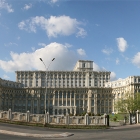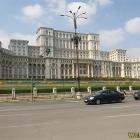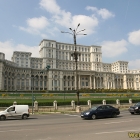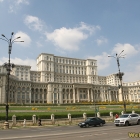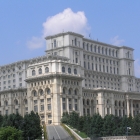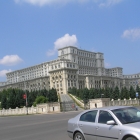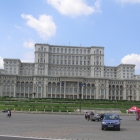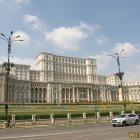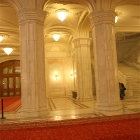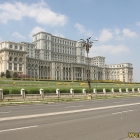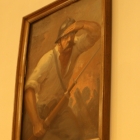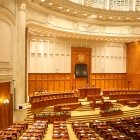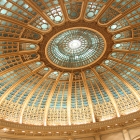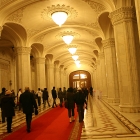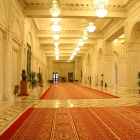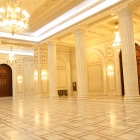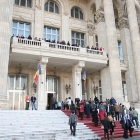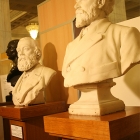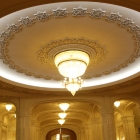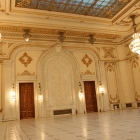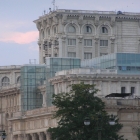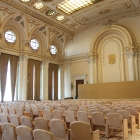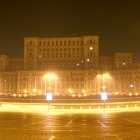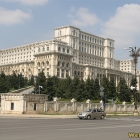Ceausescu’s Palace on The Inside (Parliament Building or House of The People)
On certain occasions, such as the national day of Romania, The House of The People, or The Parliament Palace built by the communist dictator, Nicolae Ceaușescu in the capital Bucharest is fully opened to the public and cameras. Usually, tours for tourists exclude the greater rooms of the building as various conferences take place there (corporate and political events), including the meetings of the Romanian Parliament. Due to its history, the giant building is largely hated by locals, but the good news is that this cube of marble and concrete looks better on the inside than on the outside, maybe because a great part of the decoration is recent, in the years that followed the anticommunist Revolution from 1989.
Locals still call this building by the name gave by the dictator: The House of The People – a quite cynical name when you think that the people not only had to pay the huge price tag of the building, but it wasn’t even aloud to walk on the streets outside the gates. You need to imagine, boulevards larger than Champs Elysee almost empty to enter the atmosphere of this colossus. Car traffic was allowed here only after the Revolution, but most of the stores located there soon went bankrupt as people continued to prefer the other boulevards for evening walks. The reason? These streets simply didn’t went anywhere, in stead, they stopped in front of this fortress. The proportions of this building talk about a system that occupied the country for 44 years and which seemed to be eternal – you look at it and realize that any form of rebellion would be futile against the power of a totalitarian state
The House of The People from Bucharest is in the Guinness Book of World Records as the greatest civil structure on Earth, and the second building after the Pentagon. Its total surface is of 330.000 sq m.
The chief-architect of the Palace was a woman, Anca Petrescu. For building it starting 1983, entire neighborhoods war erased, a surface later compared with the size of Venice. There were demolished churches, valuable historic constructions and 40.000 people were forced to move. Most of them, to uncomfortable blocks of flats in proletarian areas of the city.
The number of people that died building The House of The People is unknown, but workers and soldiers brought from allover the country worked in conditions very resemblant to slavery in a round a clock site that lacked elementary living conditions; even toilets were a problem for the workers. In the ’80s here worked 20.000 men in shifts for all 24 h a day.
Due to Ceausescu’s nationalism, respected by the oligarchs from the Communist Party, for The House of The People, only two materials were brought from abroad. They were both gifts from other dictators, very expensive wood essences from India and Zaire (Congo), the last one, a gift from Mobutu Sese Seko. A third one, a green marble, was used after the Revolution to decorate the Meeting Room.
But in spite of this ambition, the sources of inspiration are visible: the city of Pyong Yang, built on an empty land by other communist utopians, and the French Versailles Palace. The surroundings of Ceusescu’s headquarters kept the image of a pyramidal society, with state institutions and communist officials hosted in the near blocks according to their ranks.
Nor the sum of money necessary for this building is known. Probably, only erecting this structure until 1989 when only two rooms were ready in the inside took a billion dollars. Other sources, that add also the investments after that moment advance the sum of 3 billion dollars.
The materials used include: a million cubic meters of marble, 5.500 t of cement, 7.000 t of steel, 20.000 t of sand, 200.000 cubic meters of glass. A tower of glass was added somewhere around 2004, to house the National Contemporary Art Museum. There were also added a restaurant, swimming pool, sauna, underway parking spaces, but still a part of the building is unfinished.
At the ground floor, there is also a Museum of Parliament with various decorations, historic documents, statues of political figures and paintings received by Ceausescu (Chauchesku).
Today, its main purpose is to house the meetings of the two legislative chambers – Deputy Chamber and the Senate – of Romanian Parliament. The most important room is the Assembly Hall (or the Plenum Room), with its green glass dome that sits on a golden brass structure.
The walls are covered in marble from Gura Vaii and Antigua (green marble) brought from Iraq; the doors are of massive walnut wood. The furniture is dressed in leather and has all modern conference facilities.
Other halls have names dedicated to historic events – The National Unification Room, or personalities: Ion IC Bratianu (liberal prime minister of the XX century), Nicolae Iorga (historian, writer and politician of the XX century), Nicolae Balcescu (liberal politician of the XIX century).
There are no less than 5.100 rooms in the entire building and 500 toilets.
All the carpets are manually worked at Cisnadie in one piece or assembled on place.
The largest chandelier weights 5 tons, but there are 2800 others. To light it, the chandelier uses 7000 light bolts.
Many lobbies have walls with Ruschita marble. The Nicolae Iorga hall is decorated in a German style to imitate the interior of Peles Castle from Sinaia (built by King Carol in the Carpathians).
In Nicoale Balcescu hall, the walls are of pink marble, and the curtains are weaved of silk at Sighisoara. Cherry and mahogany wood was also used here. In the IC Bratianu hall, curtains were made of red velvet with gold thread by the nouns of Agapia and Varatec monasteries.
In various rooms there are paintings and tapestries of several Romanian artists: Angela Bradean, Marin David, Ovidiu Moga, Maria Nemes, Gheorghe Simion, Nicolae Blei, Margareta Sterian.
- Home Page
start page - Architecture
landmark buildings - Sacred architecture
places of worship - Nature
landscape photography - Concert
performing artists - Christmas
Santa Claus pictures
- Jooble
jobs for photographers - Escape
an out of control blog - Merry Christmas
The best organizer of Christmas parties - Astro photo
Eclipse hunting and astrological photography

